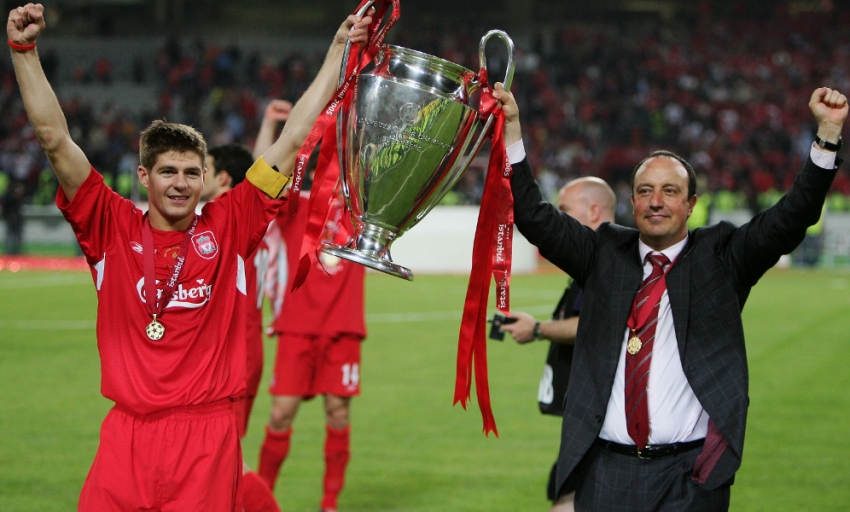Istanbul 2005: A tactical analysis
Liverpool were involved in one of the greatest European Cup finals in history on this day 10 years ago, but what brought about such an incredible turnaround?
Of course, the will of the players, the leadership of Steven Gerrard and never-say-die spirit of Jamie Carragher were crucial - but what about the tactics that brought the Reds back from the brink?
Rafael Benitez's initial tactical plan seemed a sound one. A 4-1-3-1-1, with Xabi Alonso lying deep, aimed to flood Milan's midfield and keep the game tight. It also allowed Gerrard the flexibility to help Alonso shackle Kaka as well as providing thrust alongside Harry Kewell further up the pitch.
Both teams' progress to the final had, after all, been based on defensive solidity, and it seemed that the Reds' likely path to victory was to nullify Milan while waiting for the moments of inspiration which had served them well so far.
Within a minute of kick-off, though, Benitez's plan became obsolete thanks to Paolo Maldini's unlikely volleyed goal.
Liverpool came roaring back straight away, but seeking an equaliser exposed a key tactical problem. With the onus on Luis Garcia, Gerrard and Alonso to go forward, gaps appeared in front of the back four.
Milan were also playing with no conventional wingers, meaning that Liverpool's full-backs - Steve Finnan and Djimi Traore - were often redundant. Neither were able to bomb forward with confidence and they were bypassed defensively by Milan's strength in central midfield.
Spaces appeared, ones which Andrea Pirlo and Kaka had made their names ghosting into before displaying their deadly passing skills to set-up their formidable strike force.
This was particularly seen in Milan's second goal. A promising Liverpool move that arguably should've brought a penalty and an equaliser in fact led to the entire Liverpool midfield being left on the wrong side of the ball with a simple pass. Kaka was free to find Andriy Shevchenko who squared for Hernan Crespo.
The third goal followed a similar pattern but could also be seen as a product of Milan's growing confidence - Kaka's sublime ball to Crespo was the kind of thing you see from a side who are 2-0 up and cruising.

At half-time the Reds seemed in an impossible position tactically - they were facing a Milan side who had picked them apart but in order to get back into the game would have to take more of the risks that had led to their devastation. All Milan had to do was more of what they'd done after their first goal; weather the inevitable Reds storm and pick the opposition off accordingly.
How, then, did Liverpool turn the game round from this impossible position?
The first part of the answer was moving to three at the back. For all their deadliness in front of goal and the cleverness of their running off the ball, Crespo and Shevchenko weren't blessed with frightening pace. Therefore, it was the less dangerous option to leave Carragher, Sami Hyypia and Traore three-on-two without a covering full-back than to allow Kaka and Pirlo the space they'd exploited in the first half.
Benitez brought on Dietmar Hamann for the injured Finnan and switched to a 3-4-2-1, with the four made up of the wing-backs, John Arne Riise and Vladimir Smicer, as well as the German and Alonso policing Kaka, Pirlo and Clarence Seedorf.
The wing-backs could more explicitly aim to get forward and take advantage of Milan's lack of width. But most importantly Gerrard, who had been forced to chase shadows in his dual role earlier in the game, now had the freedom to make runs into decisive areas as part of the two behind the striker.
The combination worked after just five minutes as Gerrard superbly stretched his neck muscles to power home a header from Riise's superb left-wing cross.
Two minutes later, the other wing-back found the space to hurt Milan, as Smicer smashed home a long-range effort.
The equaliser was all about Gerrard's free role; released to go marauding against Milan, his bursts of pace and energy took advantage of the Italians' major weakness. Their defence's experience may have meant they were brilliant in soaking up and nullifying Liverpool's traditional attacking play, but Jaap Stam, Maldini and Alessandro Nesta lacked the athleticism to deal with a rampant Gerrard making runs at and behind them. As a result, the captain was tugged back by Gennaro Gattuso, and Alonso scored the rebound from Dida's penalty save.
It was inevitable that a side as good as Milan would regain their composure, even after the shock of conceding three goals in six minutes. However, Alonso and Hamann did well to keep Kaka and Pirlo quiet, while Liverpool's wing-back system and Gerrard's stamina enabled the team to deploy defensive reinforcements when necessary.
Extra-time, though, posed a new problem. Carlo Ancelotti introduced his Brazilian winger Serginho, a player whose pace and skill enabled him to isolate Smicer, playing out of position in the wing-back role. Benitez had to think of a way to counter this and, as ever, the answer came in the shape of the captain.
Earlier in his career Gerrard's tackling ability sometimes saw him deployed as a right-back, and a swap with Smicer enabled Liverpool's talisman to provide the necessary protection down the right flank - even if it restricted the team's ability to threaten Milan as they had in normal time.
So how did Liverpool turn it round? Simply put, wing-backs and Gerrard. Deploying both effectively allowed the Reds to take advantage of Milan's two key weaknesses - a lack of width and relatively static backline. Meanwhile, the additional cover from Hamann ensured the team could exploit those mismatches without being exposed to the dangerous Pirlo and Kaka.
Of course, such tactical points don't fully capture the drama of that evening but it's likely that without those key switches, any chance of a comeback would've been far fetched.



